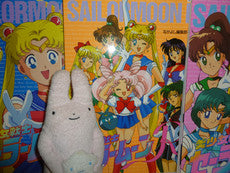PRESERVING ANIME FIGURES
By Coasty Bunny, ANIMECOAST mascot
Generally PVC figures, whether anime or otherwise, are quite sturdy and will provide decades of enjoyment for their owners. Like all material, PVC will naturally degrade over time. You can effectively slow down this process by adequate care storage of these figures. Unless a storage case is airtight, figures will eventually collect dust. Figures are often composed of numerous complex parts. The crevices on the figure are magnets for dust and dirt. Moreover, if the storage compartment is completely airtight, this can result in another problem: “Sweating”. Many collectors have noticed that some of their older PVC figures develop a sticky residue on their surface. The term was coined because the residue resembled sweat. This residue is caused by the degradation of the plasticizer within the figure. Plasticizer is a compound mixed into PVC in order to add flexibility. Unfortunately, the gasses from this plasticizer has nowhere to escape if the figure is kept sealed in an airtight container or package. Heat can also accelerate this process.
Some collectors aim to preserve their figures not only for personal enjoyment but also as an investment. Many also feel it is vitally important to archive the collectibles for future generations. After all, today's pop culture trinkets are tomorrow's priceless antiques!
CARING FOR YOUR FIGURE
Clean and Dust Regularly
Unless a space is completely airtight, some amount of dust and dirt will accumulate on your figure. Most collectors will display their figures on open shelves or some sort of glass/acrylic cabinet. Periodic dusting and cleaning of your collection is recommended.
Dusting with a small microfiber cloth or cotton Q-tips is a start. For hard-to-reach crevices, a compressed air duster can be effective.
Glass/Acrylic Cabinets for Storage and Display
Glass cabinets not only protect your collection, but look good doing it! Glass helps keep the majority of dust and dirt out. Some may even have UV coating to reduce fading from sunlight. Acrylic is another option but, depending on the size, can get expensive. Acrylic also scratches easily, which will mar the beauty of the display cabinet. The other advantage of acrylic is that it is not as fragile as glass. Keep in mind that your figures will still need occasional dusting when stored in these cabinets. Most are not manufactured to be airtight.
All displays and cabinets should be securely attached to the wall (or floor, if free-standing). This reduces the chance of the display tipping over (especially in earthquake-prone areas such as California).
Acrylic Cubes for Display
These cubes come in many different sizes and can be purchased at various stores such as Michaels, The Container Store and online. The cubes have one open side and can be placed over a figure to create an instant display. This method is nearly airtight and will almost completely eliminate the need for dusting. However, it is recommended that the figure be aired-out once every few months to release the plasticizer gasses and prevent the figure from “sweating”.
Say NO to Direct Sunlight!
Sunlight is the enemy of all collectibles, be they figures, books, toys posters or plush. UV rays can warp, melt and otherwise destroy your precious collection! The most common effect of direct sunlight is fading. Most figures are made from PVC and ABS, so leaving them in direct sunlight for extended periods will accelerate degradation of plastic and cause fading of the paint/colors.
Ideally, you should place your collection away from direct sunlight. If this is unavoidable due to space constraints or aesthetics, simply cover your display with a dark cloth or install curtains. UV coating can also be applied to windows.
Care of Accessories and Fragile Parts
Display cases can help with preventing accidental bumping of the figure. Make sure the figure's base is on a stable surface within the case. Museum putty can be used to further secure bases and figures to the surface. If there are parts and accessories that you are not currently displaying with your figure, make sure to store them in the figure's box. Alternatively, you can store them in a labeled box for easy access. Figures can lose a lot of value if they are missing an accessory, so this is crucial if you want to preserve value and collectibility.
Wash Only When Necessary
Dusting can be done frequently. However, washing should be done only when absolutely necessary.
Washing figures with warm water and mild soap is an effective way to clean figures. Gently clean them with a soft toothbrush taking care not to damage the fragile parts and paint application.
After washing, pat dry gently with a soft towel and leave to air-dry. Never use hair-dryers or any heated drying method as this will warp and possibly damage your figure. Brief application of a hair-dryer should only be used when figures are very warped and need to be straightened or if a part is too tight to snap together without breaking the figure.
Keep Your Collection Safe
Toys and figures that contain batteries should have them removed prior to storage or display. Batteries can leak or explode if kept for long periods in a toy. Heat can exacerbate this.
White cotton gloves are recommended when handling or cleaning figures. This protects the figures from the oils and sweat present on your hands.
If you happen to have a collection that is worth large sums of money, consider insurance. Just as one would insure a vehicle or property, once a collection reaches a high enough value (determined individually) insurance is recommended.







